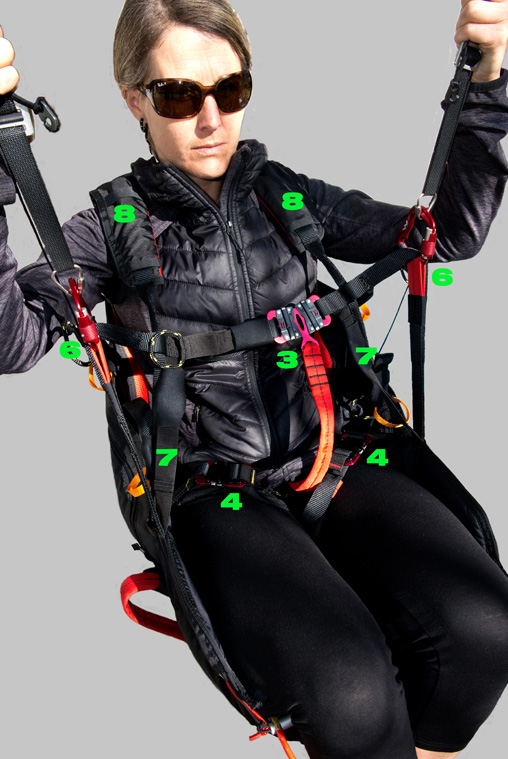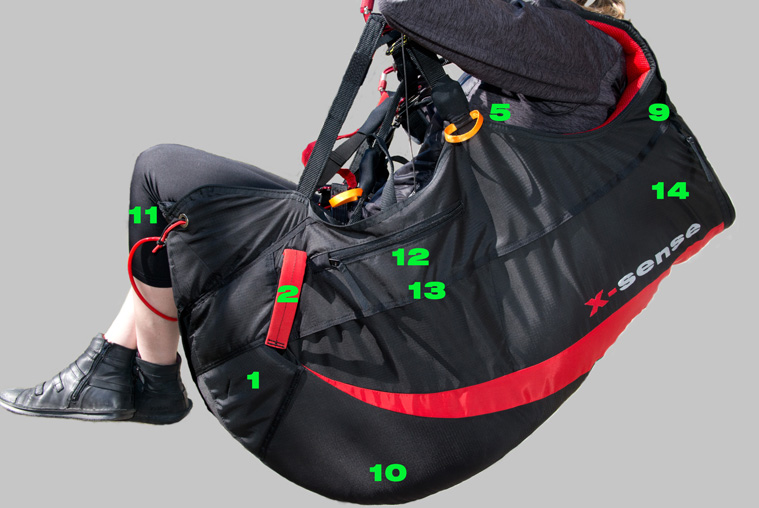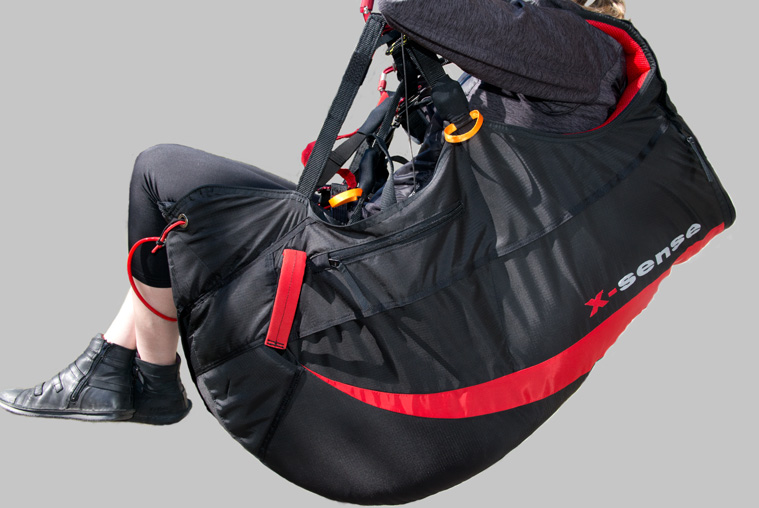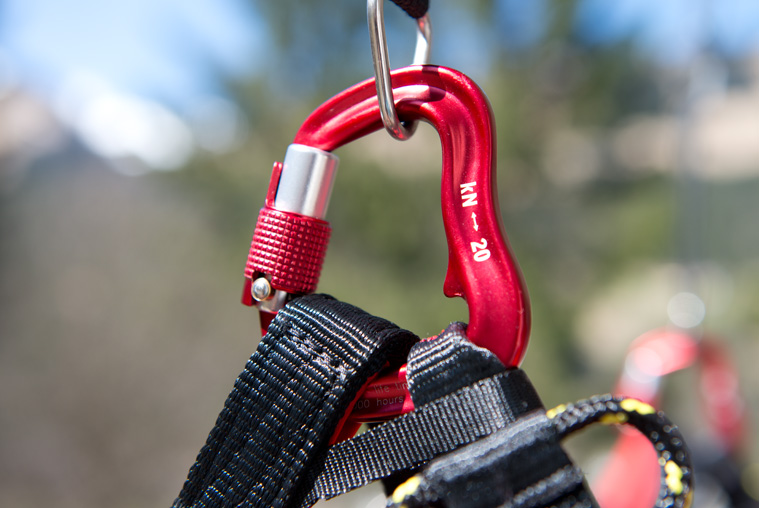Based on years of experience the X-SENSE offers new technological solutions. The construction enhance SAFETY and FLIGHT PLEASURE, with criteria such as safety, lightness, comfort, controllability through weight shift and feedback. Thanks to the frame construction and its active controllability by the special belt geometry, it fulfills the requirements of numerous pilots and remains thereby very light and easy to transport.
It is fully approved according to the LTF-EN protocol. The seat board is asymmetrically and made out of a honeycomb structure. A 6-leaf bottom container, rescue handle can be mounted on the right or left side, very good feedback and extremely precise body weight shift option are only a few points which characterize
the X-SENSE.
TECHNICAL DATA
- EN & LTF certification PH 176.2016
- max. pilot weight 110 kg
- 18 cm foam protector
- leg, chest, hip & shoulder straps adjustable during flight
- ABS system
- speed bar in place holder (rubber)
- 6-leaf bottom container
- mounting of the rescue handle right and left possible (right or left hander)
- loops on the shoulder straps for fixing steerable rescues
- anatomically shaped back part for optimum support
- very precise feedback and extreme weight shift possible
- asymmetric seat board
- channel for camel bag tube
|


1. Rescue container
2. Rescue operation (right or left)
3. Chest belt T-lock system
4. Leg belts
5. Lateral chest-waist belt | Lordosis
6. Main suspension
7. ABS system
8. Shoulder belt
9. Suspension – rescue connection line right or left
10. Protector
11. Speedbar and speed bar rubber (optional)
12. Deflection – pulley speedbar concealer
13. Reflection Ring – accelerator returns rubber concealed
14. pockets
Construction X-SENSE
The X-SENSE is equipped with a fixed sewn in V-line to connect the rescue to the
harness. It is also possible to install steerable rescue devices (such as the X-Curve,
X-Triangle or other brands) by using mailon rapide carabiners.
We developed and optimized the container in the G-Force trainer for an easy
opening even under high G-loads.
The rescue handle can be mounted on the right or
left side of the harness.
The chest strap is closed with the T-Lock system attached to one of the leg belts. Adjustments in length can be done by the clasp and should not be tightened too
much. We recommend that you use a wide chest belt distance in the X-SENSE harness and, if desired, to reduce | dampen the bodymovement and roll sensibility
trough the ABS-system. This procedure and possibility to dampen the harness via the ABS-system and not as before by a tighten the chest strap reduces the danger of twists considerably. The shoulder straps are optimized for a comfortable pilots position and easy adjustment even during flight.

The adjustment of the lateral chest strap should be synchronized with the shoulder strap and allows the variation of the sitting position from sitting to rather lying. On the other hand with this side straps the most comfortable sitting position can be found. Likewise, the angle of the seat board is affected of this adjustment as well. Take care that the body load is spread evenly on the shoulder strap and the chest strap during adjusting. The back of the harness should apply uniform pressure in the lower back, lumbar area up to the shoulder of the pilot. The buttocks should define the lowest point of the sitting position.
The leg straps are solved as individual straps and thus enable a maximum of body shift-weight control and feedback without restricting the pilot in his movements.
This adjustment affects the flying performance. The looser it is the less stable the harness becomes and therefore its more sensitive to pilot movements and control by
weight shift. Vice versa the tighter it is adjusted the more stable the harness becomes requiring more pronounced pilot movements in flight. The ABS belt adjustment is the only one on the X-SENSE harness which can not be done during the flight. However it is very easy to test this setting already in the simulator
and feel the difference.
You can see in the schematic description how the speedbar rope is running. The rope of the speedbar runs down from the risers to the pulley above the seatboard. The speedbar rope leaves the harness at the frontal edge of the seat board through the eyelet. Then the rope gets connected with the speedbar. The speedbar itself can be secured with the velcro below the seat board edge. In the harness are 3 rings sewned in for mounting the speedbar rubber. Whether this rubber is installed or not is left to the pilot himself.
Not like conventional solutions, the X-SENSE rubber runs over the entire back area trough three rings, resulting in a higher rubber length. This allows the rubber to be more tightly clamped and the efficiency and longevity is immensely increased.
The harness manufacturer Woody Valley has developed a new paraglider carabiner together with the Italian metal workshop Camp – with a few interesting ideas.
Skyway is the new type of carabiner that has been specially adapted for paragliding at seven points.
- The narrow tip should simplify the threading of the riser strap.
- The supporting arm is not straight but slightly slanted shape. Also narrow riser straps should always automatically slip into the back corner and maintain their position there.
- The small nose is designed to prevent the carabiner of tangling into the harness belt.
- The inscription refers to the durability and reminiscent of the exchange at least every 5 years.
- Production date and number.
- On the bevelled front swingarm the belts can better rest.
- A small nose supports the slide opening and prevents that scrapes the knurled wheel on the carabiner.

The skyway weighs 48 grams per piece. This is 12 grams less than the Camp-Paratwistlock carabiner used so far by Woody Valley. According to Woody Valley, the new model also improved the strength in both longitudinal and transverse tensile loads.
Break load: 2,000 DaN
Suitable for harnesses with a belt width of 40 mm
Height inside: 50 mm
Interchange interval in mono use: 5 years or 2000 hours
Interchange interval in the tandem operation: not suitable for tamdem flying
Weight: 48 g | piece
In the back storage is an extra compartment for a drinking bag/bottle
sewn in (up to 1,5 l). The drinking tube itself can be carried out in the back
and on the right shoulder strap.




